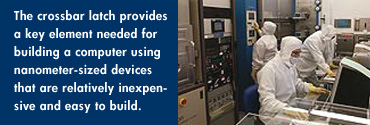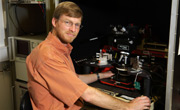
by Rodney L. Merrill
The often-quoted Moore's Law says that we can expect processors
to double in capacity every 18 months. And that has held
true. Now computer scientists warn that without some significant
breakthrough further advances in computing power and speed
will be halted in the next decade by the physical limitations
of conventional silicon technology.
But scientists in HP Labs have demonstrated that it could
be possible to continue advancing computer power by eliminating
the need for transistors the basic building block of computing
for the last 50 years. In a paper published today in the
Journal of Applied Physics(1), three
members of HP Labs' Quantum Science Research (QSR) group
in Palo Alto offer a feasibility-level description and demonstration
of the "crossbar latch" a bistable-switch latch that promises
to replace the traditional transistor and to resolve some
issues that have stymied progress in molecular scale computing.
 |
|
While a patent for the crossbar latch was granted in 2003,
this article reports on experiments that demonstrate that
the theoretical construct actually works. The invention is
a key step in going beyond the material limits of conventional
silicon processes. Using electronic devices created by trapping
an electrically switchable layer only a few atoms thick between
crossed wires, a bit of memory can be stored or a logic function
can be performed at each intersection of wires.
Standard semiconductor circuits require three-terminal transistors
to perform the 'NOT operation'(2) and restore
signals. However, it is generally believed transistors will
not function at sizes of a few nanometers and that is why
there is a practical limit to their miniaturization.
HP researchers and their academic colleagues are believed
to be the first to propose an architecture for molecular
electronics based on programmable crossbar circuit arrays
populated with two-terminal devices at each crosspoint. At
issue, however, has been how to manage signal restoration
and inversion in a general computing scheme that does not
rely on transistors. The crossbar latch is the solution to
both problems.
"We are reinventing the computer at the molecular scale," said
Stan Williams, HP Senior Fellow and QSR director, and one
of the authors of the paper. "The crossbar latch provides
a key element needed for building a computer using nanometer-sized
devices that are relatively inexpensive and easy to build." A
nanometer is one billionth of a meter or 39/1,000,000,000
inch.
In the journal article, HP Lab researchers describe and
demonstrate a microscopic device consisting of a single wire
acting as a signal line, crossed by two control lines with
an electrically switchable molecular-scale junction where
they intersect. By applying a sequence of voltage impulses
to the control lines and using switches of opposite polarities,
the latch can perform the NOT function essential for general
computing operations. In addition, it can restore a logic
level in a circuit to its ideal voltage value, allowing a
designer to chain many simple gates together to perform an
arbitrary computation.
In principle, these operations enable universal computing
for crossbar circuits, and potentially integrated nanoscale
electronics. And that means Moores Law may hold on for another
50 years with the potential for processors that are thousands
of times more powerful than today.
"We have previously demonstrated that we could make a working
memory with molecular-scale junctions and logic devices that
could perform simple logic operations such as AND and OR," said
Duncan Stewart, QSR scientist and one of the authors of the
paper. "With the crossbar latch, we now have the final component
theoretically needed for performing the multiple processing
steps required for useful computing at the nanoscale."
As Moore's Law begins to collide with the laws of physics,
HP Labs (and collaborators at Imaging and Personal Systems
Group in Corvallis) is leading an effort to provide a scientifically
sound, practical, economical alternative to silicon technology.
"The technical problem we face is to make extremely small
electronic components (at the molecular scale), use very
large numbers of these components to make very complex circuits,
but manufacture these circuits at much less cost than today's
integrated circuits," says Phil Kuekes, another author and
senior architect, QSR. "This requires many disciplines to
work together. To make them function at the smallest scales,
we use quantum physics. To achieve massive complexity, we
use computer architecture. To keep them inexpensive, we use
low mechanical precision and do self-assembly with chemistry.
And to deal with the inevitable defects of chemical self-assembly,
we use defect tolerant design algorithms." These algorithms
enable computer architects to design around flaws in chips.
None of this is going to happen tomorrow. But the way has
been paved.
"Transistors will continue to be used for years to come
with conventional silicon circuits," said Kuekes, "but this
could very well replace transistors in computers someday,
just as transistors replaced vacuum tubes and vacuum tubes
replaced electromagnetic relays before them."
Kuekes was previously awarded a patent on the crossbar latch
(U.S. 6, 586,965) in July 2003, and the Journal of Applied
Physics report, entitled, "The crossbar latch: Logic value
storage, restoration and inversion in crossbar circuits," demonstrates
the application of the technology. Stewart performed most
of the testing that demonstrated the device actually works.
The paper underwent rigorous peer review before being published.
While a patent for the crossbar latch was granted in 2003,
this article reports on experiments that demonstrate that
the theoretical construct actually works. The invention is
a key step in going beyond the material limits of conventional
silicon processes. Using electronic devices created by trapping
an electrically switchable layer only a few atoms thick between
crossed wires, a bit of memory can be stored or a logic function
can be performed at each intersection of wires.
| (1) |
Kuekes, Philip J.,
Duncan R. Stewart and R. Stanley Williams, Hewlett-Packard
Laboratories, Quantum Science Research group. The crossbar
latch: Logic value storage, restoration, and inversion
in crossbar circuits. In Journal of Applied Physics
97, 034301 (2005).
Journal of Applied Physics is the bimonthly peer
reviewed archival journal of the American Institute
of Physics that focuses on significant new results
in applied physics.
The research on the crossbar latch was partially
supported by the Defense Advanced Research Projects
Agency (DARPA).
|
| (2) |
Digital logic, which
is the basis for nearly all electronic computers today,
is based on "Boolean operations" on the two digits
one (1) and zero (0). The NOT function is
one of those operations and is the very simple operation
that NOT(1) is zero and NOT(0) is one. This
ability to logically turn a one into a zero and vice
versa is an absolute requirement for performing general
computing. |
|
 |

Duncan Stewart,
Scientist in the Quantum Science Research group
 Phil Kuekes,
Senior Scientist in the Quantum Science Research group Phil Kuekes,
Senior Scientist in the Quantum Science Research group
|
